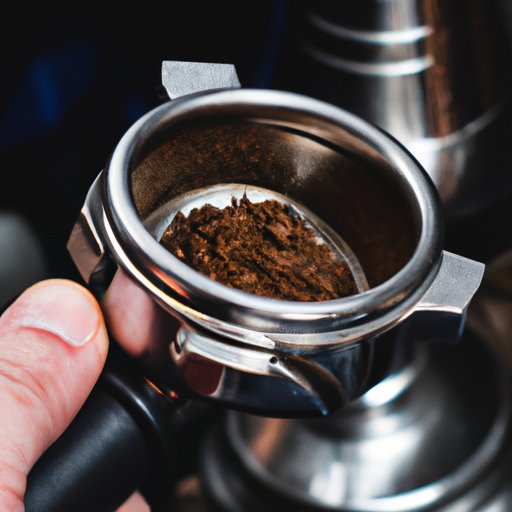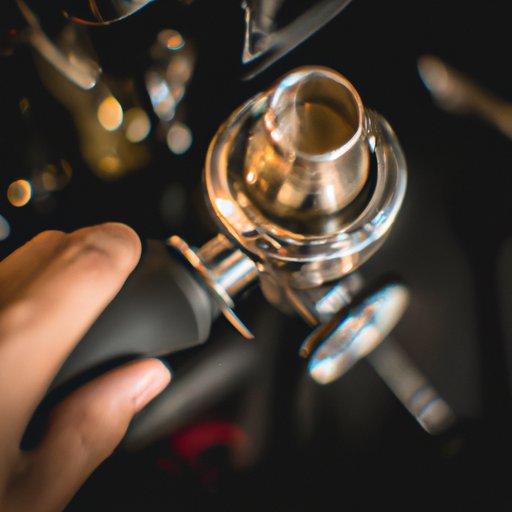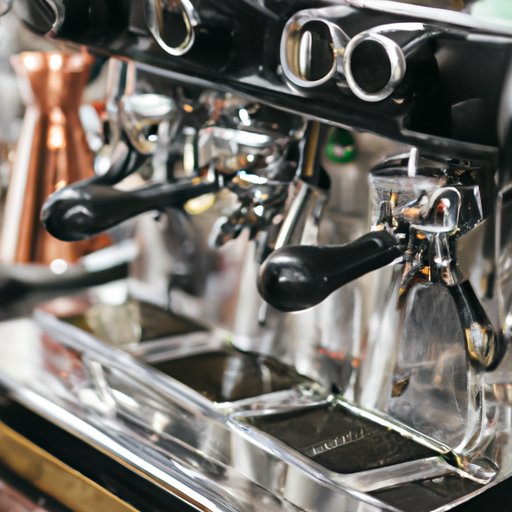Introduction
Coffee makers are one of the most popular kitchen appliances. But how does a coffee maker work? This article will explain the science behind the process and provide an in-depth look at the different types of coffee makers, their components, and troubleshooting tips.
Step-by-Step Guide to Operating a Coffee Maker
To begin, there are a few supplies you’ll need to gather before operating your coffee maker: fresh, cold water, freshly roasted beans, and a grinder (if necessary). Once you’ve gathered everything you need, you can start preparing your ingredients.
If you’re using pre-ground coffee, you can skip the grinding step. But if you’re using whole beans, you’ll need to grind them first. This is important because the size of the grounds affects the flavor and strength of the coffee. For a strong cup of coffee, you’ll want to use fine grounds.
Once the beans are ground, you’re ready to set up the machine. Fill the reservoir with cold water and add the grounds to the filter. Place the filter in the filter basket and close the lid. Now you’re ready to start brewing!
Turn on the machine and wait for the brewing process to complete. Depending on the type of coffee maker you have, this may take anywhere from 5-15 minutes. When the brewing is complete, turn off the machine and enjoy your freshly brewed cup of coffee.
Finally, it’s important to clean and maintain your coffee maker regularly. After each use, make sure to empty out the filter and rinse it thoroughly. If your machine has a removable water reservoir, be sure to empty it and fill it with fresh water each time you brew a new pot of coffee. Additionally, descaling your machine once every few months will help keep it running smoothly.
The Science Behind the Coffee Maker: How Does It Work?
Now that we’ve gone over the basics of operating a coffee maker, let’s dive into the science behind the process. The first step is heating the water. Most machines use a boiler or heater to heat the water to the optimal temperature (around 195-205°F). This ensures that the water is hot enough to extract the flavor from the coffee grounds.
Next, pressure and extraction come into play. As the hot water passes through the grounds, the pressure forces the water to extract the flavor and oils from the beans. This creates the flavorful coffee we know and love.
Finally, the automation of the process makes it incredibly convenient. Once the machine is set up, all you have to do is press a button and wait for the brewing process to complete. This allows you to easily enjoy a freshly brewed cup of coffee without having to manually measure and grind the beans.

From Bean to Cup: Exploring the Process of a Coffee Maker
It’s important to understand the process of a coffee maker in order to get the most out of your machine. First, the beans must be roasted. Roasting helps to bring out the flavor of the beans and gives them the signature aroma we associate with freshly brewed coffee.
Once the beans are roasted, they must be ground. The size and texture of the grounds will affect the flavor and strength of the coffee, so this step is very important. For a strong cup of coffee, you’ll want to use fine grounds.
Finally, the grounds must be brewed. Hot water is passed through the grounds, which extracts the flavor and oils from the beans. This creates the flavorful coffee we know and love.
Types of Coffee Makers: How Do They Differ?
There are several different types of coffee makers available on the market today, each with its own unique features and benefits. Let’s take a look at some of the most popular types:
Drip Coffee Makers: This type of machine uses a filter to hold the grounds while hot water is gradually passed through them. This yields a mild, balanced cup of coffee.
Single Serve Coffee Makers: These machines are designed to brew one cup of coffee at a time. They often use pods or capsules filled with pre-ground coffee.
French Press: This type of coffee maker uses a plunger to press the grounds to the bottom of the carafe. This yields a robust, flavorful cup of coffee.
Espresso Machines: Espresso machines use high pressure to force hot water through finely ground coffee. This results in a strong, intense cup of coffee.
An Overview of the Different Components of a Coffee Maker
Now that we’ve explored the different types of coffee makers, let’s take a look at the components that make them work. The following are some of the most common components found in coffee makers:
Boiler/Heater: This component is responsible for heating the water to the optimal temperature.
Pump: This component is responsible for creating pressure, which is necessary for extracting the flavor and oils from the beans.
Thermostat: This component helps to regulate the temperature of the water.
Filter: This component holds the grounds while the water passes through them.
Grinder: This component grinds the beans to the desired size and texture.
Portafilter: This component holds the grounds in place while the water is passed through them.

Common Troubleshooting Tips for Coffee Makers
Even the best coffee makers can run into issues from time to time. Here are a few common troubleshooting tips to keep in mind:
Not Enough Flavor: If your coffee doesn’t have enough flavor, try using finer grounds or increasing the amount of grounds used.
Too Much Flavor: If your coffee is too strong, try using coarser grounds or decreasing the amount of grounds used.
Poor Extraction: If your coffee isn’t extracted properly, check to make sure the filter is properly placed and the grounds are evenly distributed.
Inconsistent Temperature: If your coffee isn’t the right temperature, check to make sure the thermostat is working properly and the water is heated to the proper temperature.
Conclusion
In conclusion, this article has provided an in-depth look at how a coffee maker works. We’ve explored the science behind the process and discussed the different types of coffee makers and the components that make them work. We’ve also gone over some common troubleshooting tips to help keep your machine running smoothly.
(Note: Is this article not meeting your expectations? Do you have knowledge or insights to share? Unlock new opportunities and expand your reach by joining our authors team. Click Registration to join us and share your expertise with our readers.)
